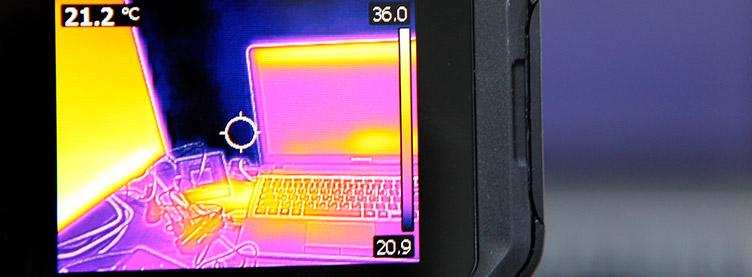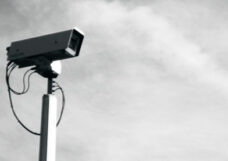
Applications of thermographic cameras per sector
May 29, 2019
Thermal cameras have gone from being a distant technology available to few, to becoming a reality that is increasingly present in several industrial and commercial sectors. The latest advances in video analytics have turned them into even more efficient surveillance systems that can be applied in several sectors.
The ability that a thermographic camera has to detect infrared radiations can be used to prevent undesired situations. A good example of this is the visible loss of heat when there is a leak inside a pipe or vent, or an increase in the amount of blood at a specific point of an animal’s body, which would reveal that it has suffered an internal injury or lesion. After knowing what a thermal camera is and how it works, we will explore some of their most important applications.
Possibilities offered by thermographic cameras
Thermographic cameras have several applications because they have the advantage of using non-intrusive procedures to compile valuable information. Unlike other mechanisms, they provide faithful data in real time about different situations without the need to have direct contact. For example, they can be used to detect the effectiveness of an insulation system or the existence of any deficiency in the building components of a building. With this, it is possible to collect information on the spot and have a first diagnostic, avoiding costlier and slower analyses.
Nowadays, thermal cameras are compact, light, ergonomic systems that are easy to use with little prior knowledge, which puts them within reach of a great number of professionals. Their performance has increased exponentially and current models offer high resolution images, issue reports, perform inspections and have Wi-Fi compatibility, which allows them to transfer and share images wirelessly with other devices.
This is why several companies from different sectors have increased their demand for thermal cameras, to add them to their video surveillance systems.
Applications of thermographic cameras per sector
Medicine and veterinary medicine
The veterinary applications of a thermal camera are many, such as non-invasive medical analyses or the detection of lesions revealed by an increase in the blood flow at specific points. In the event of a natural catastrophe, thermographic cameras have proven useful to detect the presence of live beings, even in areas that were hard to access by rescue teams. Another application of this technology in the veterinarian sector is the localization of invasive animals and nests both in crops and in enclosed spaces such as greenhouses, industrial plants, homes, etc.
Veterinary, by Grekkom Technologies, is the best thermographic camera for veterinarian clinics, racetracks and stables, zoos and oceanography. It is capable of detecting temperature shifts that may be a symptom of diarrhea, infections, inflammations or muscle strain.
Maritime
In the maritime sector, where large industrial machines are used, an infrared camera can detect a great variety of incidents quickly and easily, with the resulting time and cost savings that this implies when compared to a situation in which repairs have to be made after stopping the machine.
Thermographic cameras can reveal that a pump is overloaded due to an extra effort or that an engine is overheating. They are also very useful to locate overheated rolling bearings and abrasions when diagnosing lubrication issues, since machines that have low oil levels or overheated oil can be quickly discovered.
On the other hand, vessels of all kinds use thermographic cameras to sail by night and increase the underwater vision, in addition to using them for searches in situations such as a passenger going overboard. But, in particular, these security systems are useful for the surveillance of ports where important loads are transported and must be continuously under watch.
Grekkom Technologies has a series of products with the most advanced technology for their application in maritime environments, such as Transformer monitoring, designed for the analysis and control of overheating parts in critical machinery, or Engine monitoring, which can detect overheating in vehicles and their components.
Sentinel CCTV is an advanced intrusion detection system for restricted areas, while Deck Surveillance is specifically designed to detect intruders on ship decks. Anchor can be used to detect, locate and track vessels in sea, river and port settings, while Temp Thres-hold is an analytic technology for thermographic cameras developed to detect temperature shifts and fire in critical scenarios.
Airports
Thermographic cameras are used in airports for different purposes, such as the confiscation of drugs at checkpoints or, in case of health risk alerts, to locate passengers that are affected by an infectious disease. This latter application has the advantage of being non-invasive and quick, which is essential in places that have a significant affluence of people.
Grekkom Technologies has developed HTC Embedded for AXIS Cameras, a system that can reveal the presence of people with fever. In addition, thermographic cameras can also be used to reinforce certain security perimeters at airports under specific circumstances.
Nuclear
The relationship between cameras that detect infrared radiations and nuclear plants involves the supervision of these high-security installations. They may also be used for the detection of nuclear and radiological hazards. The speed with which these devices can detect and diagnose, while being operational 24/7, is highly useful in the performance of thermographic analyses in the energy sector.
For the performance of thermographic analyses and the detection of failures in the lining of hazardous material deposits, Tank monitor is an advanced solution that offers real-time temperature variation reports.
Oil & Gas
Thermal imaging cameras are used in the oil & gas industry to locate leaks in pipes, tanks and facilities. They are part of the preventative maintenance actions, which are paramount to improve both safety and profitability and reduce emissions to the environment. In this way, undesired shutdowns and interruptions are avoided, with the subsequent losses that these imply. Thermographic cameras are contactless and can quickly explore large areas, as is the case of Flame monitor, a flare and flame detection and analysis system to guarantee an adequate incineration of emitted gasses. Leak detector, on the other hand, finds gas and liquid leaks.
Mining
In mining, thermal camera technology is used to prevent incidents and test the operation of conveyor belts, rolling bearings, pulleys, belts and motors. Using them has the advantage that the presence of dust and smoke does not affect obtained results. The infrared wavelength of these types of cameras facilitates the detection of any thermal energy under practically every environmental condition.
On the other hand, in coal mining it is common to store coal in large containers, which requires the performance of regular thermal studies of the bottom to prevent auto-ignition.
Tube Surveillance is an advanced tunnel intruder detection system that can be complemented with Temp Thres-hold, an analytics system for thermographic cameras that reveals temperature changes and fire in critical scenarios, and with Watchman, for the detection of fire in critical scenarios or areas of high ecological value.
Renewables
Thermal imaging cameras are tools that are used in the renewable energy sector, for example, to perform the maintenance of photovoltaic panels. These checks can detect anomalies such as defective welds or damaged cells, which might affect their performance. Cell Monitor can be used to detect defects and conductivity issues in solar panels quickly and reliably.





